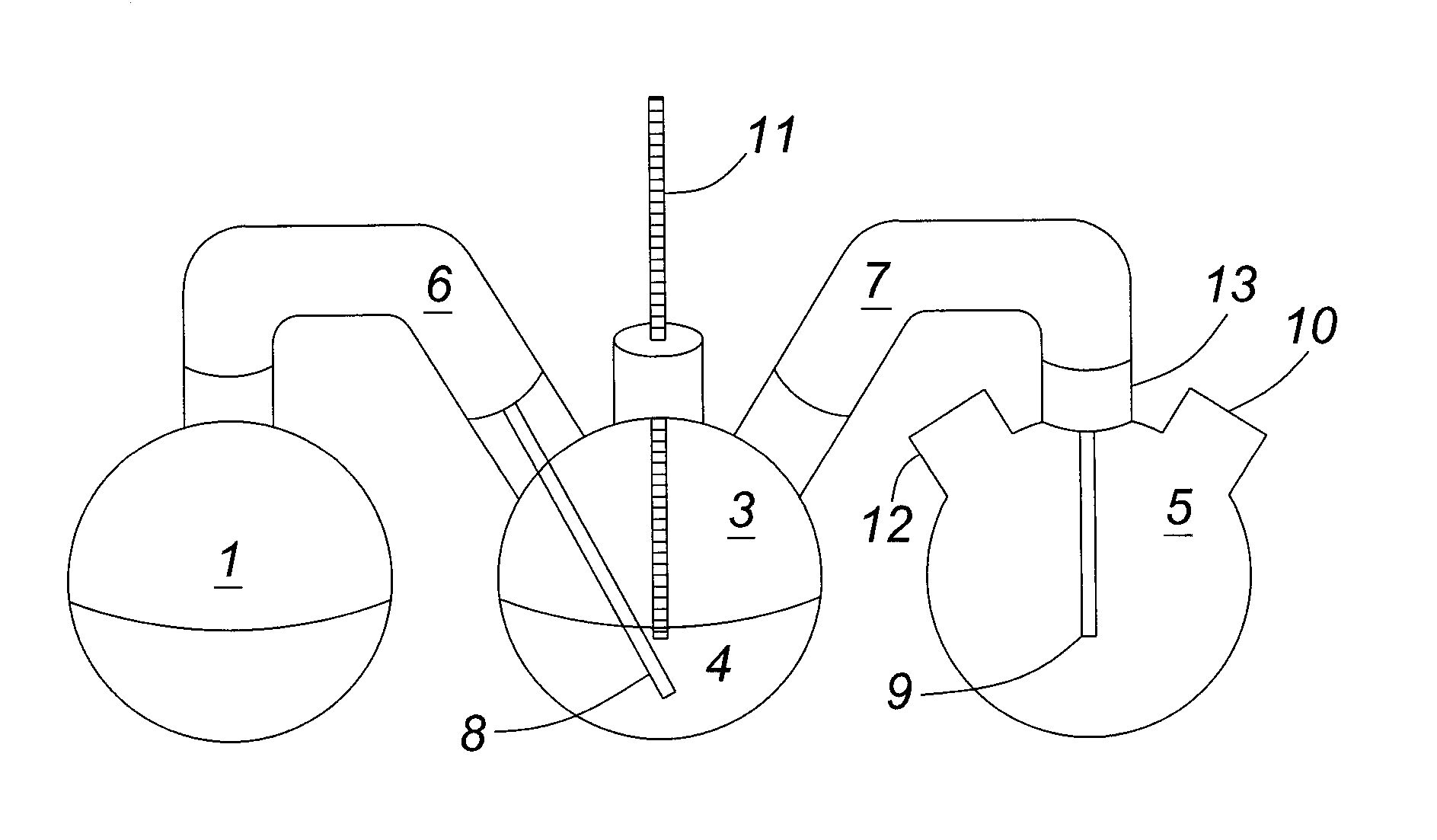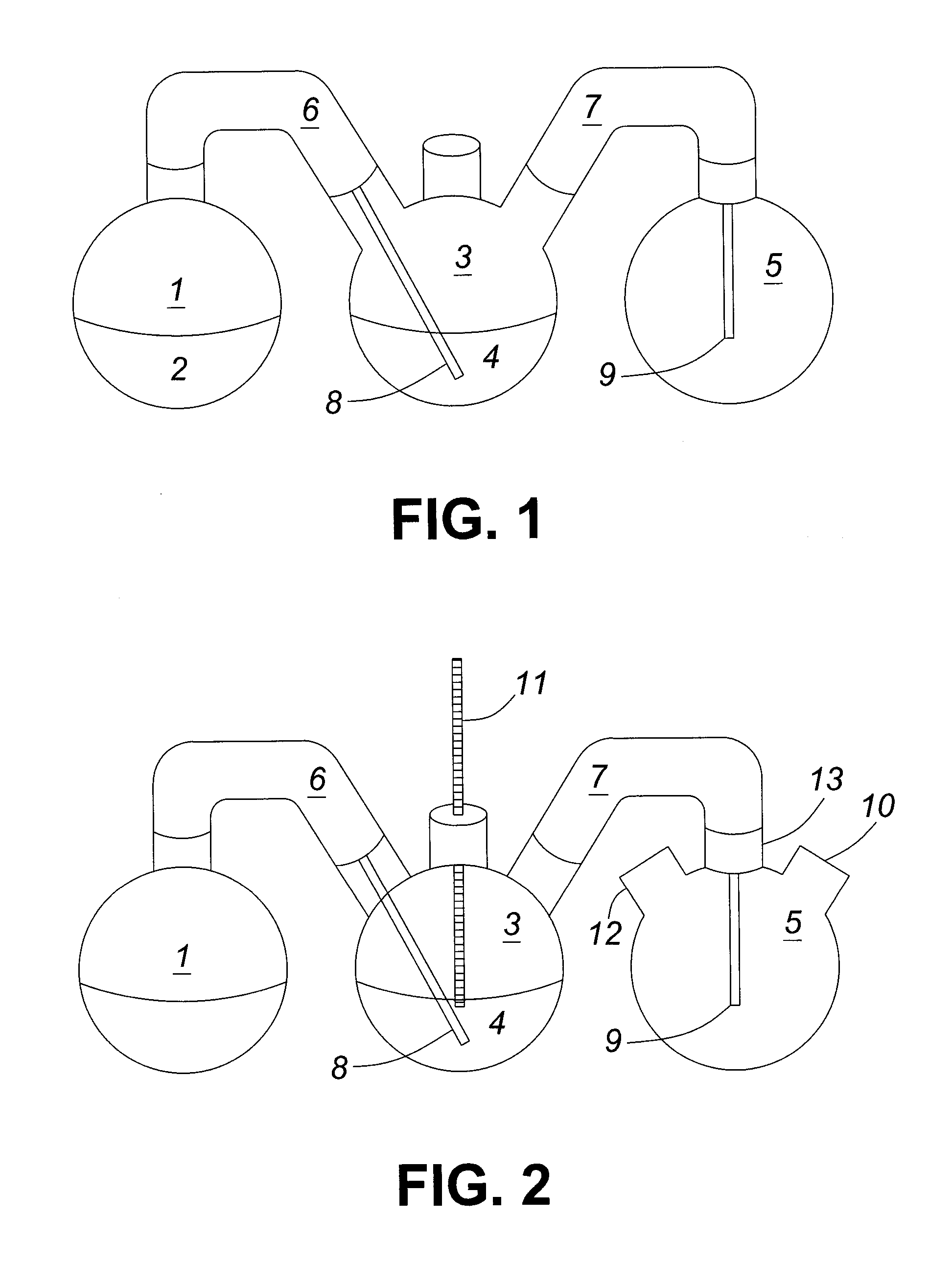Recovery of volatile carboxylic acids by extractive evaporation
a carboxylic acid and extractive evaporation technology, which is applied in the field of volatile carboxylic acids, can solve the problems of high solvent cost, enormous untapped potential for their use, and high concentration of carboxylic acids in such streams, and achieves high energy cost, simple and cost-effective
- Summary
- Abstract
- Description
- Claims
- Application Information
AI Technical Summary
Benefits of technology
Problems solved by technology
Method used
Image
Examples
example 1
Extraction of Acetic Acid from the Vapour Phase at Atmospheric Pressure Using the Apparatus of FIG. 1
[0134]This example demonstrates, using the lab scale apparatus shown in FIG. 1, that a solution of acetic acid can be effectively recovered from an acetic acid-containing vapour stream by contacting the vapour stream with an organic solvent. In this particular example, the organic solvent employed was a mixture of the aliphatic amine, Alamine® and the alkylphenol, nonylphenol.
[0135]The apparatus shown in FIG. 1 depicts a feed flask 1, a scrubber flask 3 and a collection flask 5. A first glass adaptor 6 connects the feed flask 1 to the scrubber flask 3 and a second glass adaptor 7 connects the scrubber flask 3 to the collection flask 5. Both glass adaptors 6 and 7 are insulated using glass wool and wrapped in aluminum foil. Inserted into the end of glass adaptor 6 that is connected to scrubber flask 3 is a glass inlet tube 8, which, in turn, extends into scrubber flask 3. A similar gl...
example 2
Extraction of Acetic Acid from the Vapour Phase at Atmospheric Pressure Using the Apparatus of FIG. 2
[0137]The experiment set forth in this example is similar to that described in Example 1 in that a solution containing acetic acid was passed through a scrubber flask and the acid was extracted by an organic solvent composed of a mixture of Alamine® 336 and nonylphenol during the vapour phase extraction. However, in this case the temperature of the scrubber flask was monitored and found to be 114-122° C. Furthermore, after the steam extraction, the lower limit of the apparent Distribution Coefficient (DA) was determined to be about 11 where DA=[Acetic acid]organic phase / [Acetic acid]aqueous phase.
[0138]The lab scale apparatus utilized in this example is shown in FIG. 2 and is similar to the apparatus in FIG. 1 but differs in the design of the collection flask 5 and the use of a temperature adaptor and thermometer 11 in scrubber flask 3. In FIG. 2, the collection flask 5 is a three ne...
example 3
Liquid-Liquid Extraction of Acetic Acid with Alamine® 336 and Nonylphenol at Atmospheric Pressure
[0141]This example demonstrates that acetic acid can be extracted via liquid-liquid extraction using Alamine® 336 and nonylphenol at high temperatures typical of a vapour phase extraction. In addition, it was found that increasing amounts of acetic acid were extracted as the feed acetic acid concentration was increased.
[0142]The liquid-liquid extraction of acetic acid was carried out as follows. A volume ratio of 1:1 organic to aqueous phase was used with a total volume of 10 mL. The organic phase was a mixture of Alamine® 336 to nonylphenol at a ratio of 30:70 by weight and the aqueous solutions used are listed in Table 1. Alamine® 336 is a 2:1 ratio of trioctylamine to tridecylamine. The extractions were conducted in 25 mL Erlenmeyer flasks in an incubator shaker, 400 r.p.m. at either 30° C. or 50° C. for 30 minutes. After 30 minutes, the shaking was stopped and the phases were allowed...
PUM
| Property | Measurement | Unit |
|---|---|---|
| atmospheric boiling point | aaaaa | aaaaa |
| temperature | aaaaa | aaaaa |
| temperature | aaaaa | aaaaa |
Abstract
Description
Claims
Application Information
 Login to View More
Login to View More - R&D
- Intellectual Property
- Life Sciences
- Materials
- Tech Scout
- Unparalleled Data Quality
- Higher Quality Content
- 60% Fewer Hallucinations
Browse by: Latest US Patents, China's latest patents, Technical Efficacy Thesaurus, Application Domain, Technology Topic, Popular Technical Reports.
© 2025 PatSnap. All rights reserved.Legal|Privacy policy|Modern Slavery Act Transparency Statement|Sitemap|About US| Contact US: help@patsnap.com


